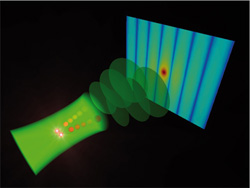A matterless double-slit

Figure 1: Two ultra-intense laser pulses (in red) are tightly focused antiparallel to a probe beam (in green). The vacuum current, activated in the interaction regions of the probe and the strong laser fields, generates photons which interfere to produce a diffraction pattern (blue background) with the alternating maxima and minima typical of double-slit experiments. <br>Photo: MPIK <br>
This employs the equally fundamental concept of the structure of quantum vacuum, which mediates between incoming photons from a probe laser and the double-slit formed from two ultra-intense laser pulses (Nature Photonics, 10 Jan 2010).
Double-slits provide incoming particles with a choice. Those that survive the passage have chosen from two possible paths which interfere to distribute them in a wave-like manner. Such wave-particle duality continues to be challenged and investigated in a broad range of disciplines with electrons, neutrons and also biological molecules. All variants of the double-slit experiment have hitherto involved material constituents.
On a seemingly different side, according to quantum electrodynamics virtual electron-positron pairs spontaneously pop into and out of existence in vacuum, on a time scale too short to be directly probed. However, the polarisation of these pairs under an applied electromagnetic field is predicted to support a rich variety of non-linear quantum processes. When driven by a strong electromagnetic field, the virtual electron-positron pairs generate a polarisation and magnetisation in the vacuum and one can form the useful analogy of the polarised quantum vacuum as a solid with non-linear response, which, instead of comprising tangible dipoles, hosts transient polarised virtual particle-antiparticle pairs. Taking the solid-state paradigm one step further, using an ultra-intense laser split into two beams, a nonlinear double-slit can be “activated” by polarising two slit-like regions in the vacuum.
Calculations performed at the Max-Planck-Institute for Nuclear Physics show that when these regions are probed with a second, counter-propagating laser field, one can create the conditions for a real photon-photon double-slit experiment, i. e. a truly quantum double-slit set-up comprising exclusively light. The researchers have simulated the collision of two ultra-intense optical laser beams with a counter-propagating probe field by including the presence of the virtual electrons and positrons in the interaction region. These virtual particles allow the strong fields to scatter the photons of the probe. The scattered photons distribute themselves in a pattern of alternating maxima and minima characteristic of double-slit experiments (Figure 1). This scenario presents on the one hand a realisable method to observe for the first time photon-photon scattering between real photons, and demonstrates on the other, the possibility of both controlling light with light as well as investigating the structure of the quantum vacuum.
Contact:
Dr. Antonino Di Piazza
Max-Planck-Institut für Kernphysik, Heidelberg
Tel: +49-6221-516-171
E-Mail: dipiazza@mpi-hd.mpg.de
Prof. Dr. Christoph H. Keitel
Max-Planck-Institut für Kernphysik, Heidelberg
Tel: +49-6221-516-150
E-Mail: christoph.keitel@mpi-hd.mpg.de
Media Contact
All latest news from the category: Physics and Astronomy
This area deals with the fundamental laws and building blocks of nature and how they interact, the properties and the behavior of matter, and research into space and time and their structures.
innovations-report provides in-depth reports and articles on subjects such as astrophysics, laser technologies, nuclear, quantum, particle and solid-state physics, nanotechnologies, planetary research and findings (Mars, Venus) and developments related to the Hubble Telescope.
Newest articles

Combatting disruptive ‘noise’ in quantum communication
In a significant milestone for quantum communication technology, an experiment has demonstrated how networks can be leveraged to combat disruptive ‘noise’ in quantum communications. The international effort led by researchers…

Stretchable quantum dot display
Intrinsically stretchable quantum dot-based light-emitting diodes achieved record-breaking performance. A team of South Korean scientists led by Professor KIM Dae-Hyeong of the Center for Nanoparticle Research within the Institute for…

Internet can achieve quantum speed with light saved as sound
Researchers at the University of Copenhagen’s Niels Bohr Institute have developed a new way to create quantum memory: A small drum can store data sent with light in its sonic…





















